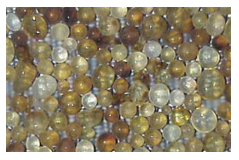Archival Notice
This is an archive page that is no longer being updated. It may contain outdated information and links may no longer function as originally intended.
Home | Glossary | Resources | Help | Contact Us | Course Map
Silica bead extractions (another solid phase extraction method) have gained popularity in research and clinical arenas; however, it is the combination of magnetic technologies and silica coatings that are being implemented in forensic laboratories.
Kits and materials for DNA extraction involving the use of silica beads are available from many companies. Similar to the Chelex® procedure, these beads are suspended in an aqueous medium and mixed with samples. Using this procedure, proteins and contaminants, which would otherwise interfere with the isolation of purified DNA, are removed. DNA binds to silica in the presence of high salt concentrations.
MO BIO offers a selection of kits under the name UltraClean ™, which are designed to extract and purify DNA samples from various sources such as blood, tissue, fecal matter, and soil.
The following are the extraction steps:
- Sample and buffer are added to a tube (provided in the kit) containing a bead solution.
- A typical extraction buffer containing sodium dodecyl sulfate (SDS) is added, followed by another solution designed to precipitate out the humic acid components and other PCR inhibitors.
- The tubes are vortexed extensively. Chemical lysis, using SDS, breaks down cell membranes and proteins, while mechanical lysis occurs as the beads physically beat up the cells.
- Centrifugation pellets the debris while the DNA remains in the aqueous supernatant.
- A DNA binding salt solution, which promotes binding of the DNA to the silica beads, is added.
- The solution of beads and DNA (in aqueous buffer) is added to a spin device. The DNA remains bound and is impeded by a membrane in the spin filter. Other molecules and contaminants pass through.
- The DNA can be washed with an ethanol solution for further purification.
- An elution buffer is added to remove the salt, thus allowing the DNA to be washed through the membrane while the silica beads are retained. The resulting filtrate is purified DNA in an aqueous buffer, suitable for quantitation.
|
Note: |
|
The kits for extracting DNA from soil and feces contain reagents that reportedly break down humic acids. |
Additional Online Courses
- What Every First Responding Officer Should Know About DNA Evidence
- Collecting DNA Evidence at Property Crime Scenes
- DNA – A Prosecutor’s Practice Notebook
- Crime Scene and DNA Basics
- Laboratory Safety Programs
- DNA Amplification
- Population Genetics and Statistics
- Non-STR DNA Markers: SNPs, Y-STRs, LCN and mtDNA
- Firearms Examiner Training
- Forensic DNA Education for Law Enforcement Decisionmakers
- What Every Investigator and Evidence Technician Should Know About DNA Evidence
- Principles of Forensic DNA for Officers of the Court
- Law 101: Legal Guide for the Forensic Expert
- Laboratory Orientation and Testing of Body Fluids and Tissues
- DNA Extraction and Quantitation
- STR Data Analysis and Interpretation
- Communication Skills, Report Writing, and Courtroom Testimony
- Español for Law Enforcement
- Amplified DNA Product Separation for Forensic Analysts


